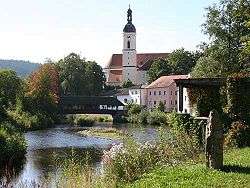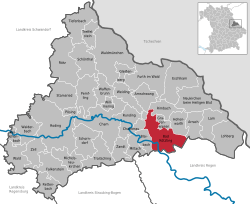Bad Kötzting
Bad Kötzting (before 2005: Kötzting) is a town in the district of Cham, in Bavaria, Germany, near the Czech border. It is situated in the Bavarian Forest, 15 km (9.3 mi) southeast of Cham.
Overview
Bad Kötzting has the charming character of a small town and offers quite a variety of attractions for tourists.
The locals pride themselves with having one of the largest mounted religious processions in the world, the "Kötztinger Pfingstritt".
Legend has it that in the year 1412, a man who got injured during forestry was asking for the last rites before dying in a village approximately 7 kilometres (4 miles) away from Kötzting. The local priest was unable to comply with the wishes of the man because he needed protection from bears, wolves, and other dangers luring along the way. After asking the young men of the village to protect him, they accompanied the priest to the dying man. After a safe journey, the participants vowed to repeat the ride every year. That is how it remained ever since. Every Whit Monday, the ride of over 900 horses and riders is repeated. The horses wear ornaments and the riders wear traditional Bavarian clothes. The ride starts in Kötzting and goes to the village "Steinbühl", where according to the legend, the man asking for anointment, was dying. Only men from the region are allowed to participate in the procession, the participating horses, however, come from all over Bavaria.[2]
The annual fair is also in town when the procession takes place. A local "Bierzelt" and numerous rides invite the public.
Historical events
| 1085 AD. | First public recording of "Chostingen". |
| 1151 | Pope Eugenius III. confirms privileges and rights of possession to Abbey Rott. |
| 1204 | A common court ("Schranne") is established in Kötzting. |
| 1260 ~ | Grant of Market status. |
| 1344 | Emperor Louis IV confirmed the market status. |
| 1425 ~ | Continuous attacks by the Hussites. |
| 1583 | "Black Death" (plague) strikes the village and surrounding areas. |
| 1614 | Ownership of land by Abbey Rott is refuted. |
| 1633 | Swedish forces burn down Kötzting (Thirty Years' War from 1618 to 1648) |
| 1648 | Last attack by Swedish forces and repeated outbreak of the plague. |
| 1770 | Widespread starvation throughout the Bavarian Forrest. |
| 1805 | Kötzting becomes independent parish. |
| 1837 | As part of a rezoning measure, Kötzting becomes part of the district Lower Bavaria. |
| 1867 | Much of the village burns down in a fire covering large parts of the town. |
| 1953 | Kötzting is granted the status of a town. |
| 1965 | A military garrison is established in Kötzting. |
| 1972 | The county of Kötzting is dissolved and the county becomes part of the county of Cham. Hence, Kötzting becomes part of the district of Upper Palatinate. |
| 1986 | Recognition as Climatic Spa. |
| 1990 | Laureate in competition "Gastliches Bayern" (guest friendly Bavaria). |
| 1992 | Opening of the Spa Gardens "Auwiesen". |
| 1994 | Title of "recreational locality" for all parts of the town. |
| 1995 | Recognition as "Garden Spa" in the tradition of Father Sebastian Kneipp. |
| 2000 | Grand Opening of the Casino in Kötzting. |
| 2002 | Expansion of the Spa Gardens "Auwiesen". |
| 2004 | Closure of the Garrison "Hohenbogen". |
| 2005 | Opening of the Open-Air and Adventure Bath ("Bathing world") AQACUR, title of Kneipp-Therapeutic Spa, and change of name to Bad Kötzting. |
International relations
Twin towns - Sister cities
Bad Kötzting is a founding member of the Douzelage, a unique town twinning association of 24 towns across the European Union. This active town twinning began in 1991 and there are regular events, such as a produce market from each of the other countries and festivals.[3][4] Discussions regarding membership are also in hand with three further towns (Agros in Cyprus, Škofja Loka in Slovenia, and Tryavna in Bulgaria).
 Altea, Spain - 1991
Altea, Spain - 1991 Bad Kötzting, Germany - 1991
Bad Kötzting, Germany - 1991 Bellagio, Italy - 1991
Bellagio, Italy - 1991 Bundoran, Ireland - 1991
Bundoran, Ireland - 1991 Granville, France - 1991
Granville, France - 1991 Holstebro, Denmark - 1991
Holstebro, Denmark - 1991.svg.png) Houffalize, Belgium - 1991
Houffalize, Belgium - 1991 Meerssen, the Netherlands - 1991
Meerssen, the Netherlands - 1991 Niederanven, Luxembourg - 1991
Niederanven, Luxembourg - 1991 Preveza, Greece - 1991
Preveza, Greece - 1991 Sesimbra, Portugal - 1991
Sesimbra, Portugal - 1991 Sherborne, United Kingdom - 1991
Sherborne, United Kingdom - 1991 Karkkila, Finland - 1997
Karkkila, Finland - 1997 Oxelösund, Sweden - 1998
Oxelösund, Sweden - 1998 Judenburg, Austria - 1999
Judenburg, Austria - 1999 Chojna, Poland - 2004
Chojna, Poland - 2004 Kőszeg, Hungary - 2004
Kőszeg, Hungary - 2004 Sigulda, Latvia - 2004
Sigulda, Latvia - 2004 Sušice, Czech Republic - 2004
Sušice, Czech Republic - 2004 Türi, Estonia - 2004
Türi, Estonia - 2004 Zvolen, Slovakia - 2007
Zvolen, Slovakia - 2007 Prienai, Lithuania - 2008
Prienai, Lithuania - 2008 Marsaskala, Malta - 2009
Marsaskala, Malta - 2009 Siret, Romania - 2010
Siret, Romania - 2010
References
- Notes
Towns and municipalities in Cham |
|---|
| | |
|



 Altea, Spain - 1991
Altea, Spain - 1991 Bad Kötzting, Germany - 1991
Bad Kötzting, Germany - 1991 Bellagio, Italy - 1991
Bellagio, Italy - 1991 Bundoran, Ireland - 1991
Bundoran, Ireland - 1991 Granville, France - 1991
Granville, France - 1991 Holstebro, Denmark - 1991
Holstebro, Denmark - 1991.svg.png) Houffalize, Belgium - 1991
Houffalize, Belgium - 1991 Meerssen, the Netherlands - 1991
Meerssen, the Netherlands - 1991 Niederanven, Luxembourg - 1991
Niederanven, Luxembourg - 1991 Preveza, Greece - 1991
Preveza, Greece - 1991 Sesimbra, Portugal - 1991
Sesimbra, Portugal - 1991 Sherborne, United Kingdom - 1991
Sherborne, United Kingdom - 1991 Karkkila, Finland - 1997
Karkkila, Finland - 1997 Oxelösund, Sweden - 1998
Oxelösund, Sweden - 1998 Judenburg, Austria - 1999
Judenburg, Austria - 1999 Chojna, Poland - 2004
Chojna, Poland - 2004 Kőszeg, Hungary - 2004
Kőszeg, Hungary - 2004 Sigulda, Latvia - 2004
Sigulda, Latvia - 2004 Sušice, Czech Republic - 2004
Sušice, Czech Republic - 2004 Türi, Estonia - 2004
Türi, Estonia - 2004 Zvolen, Slovakia - 2007
Zvolen, Slovakia - 2007 Prienai, Lithuania - 2008
Prienai, Lithuania - 2008 Marsaskala, Malta - 2009
Marsaskala, Malta - 2009 Siret, Romania - 2010
Siret, Romania - 2010